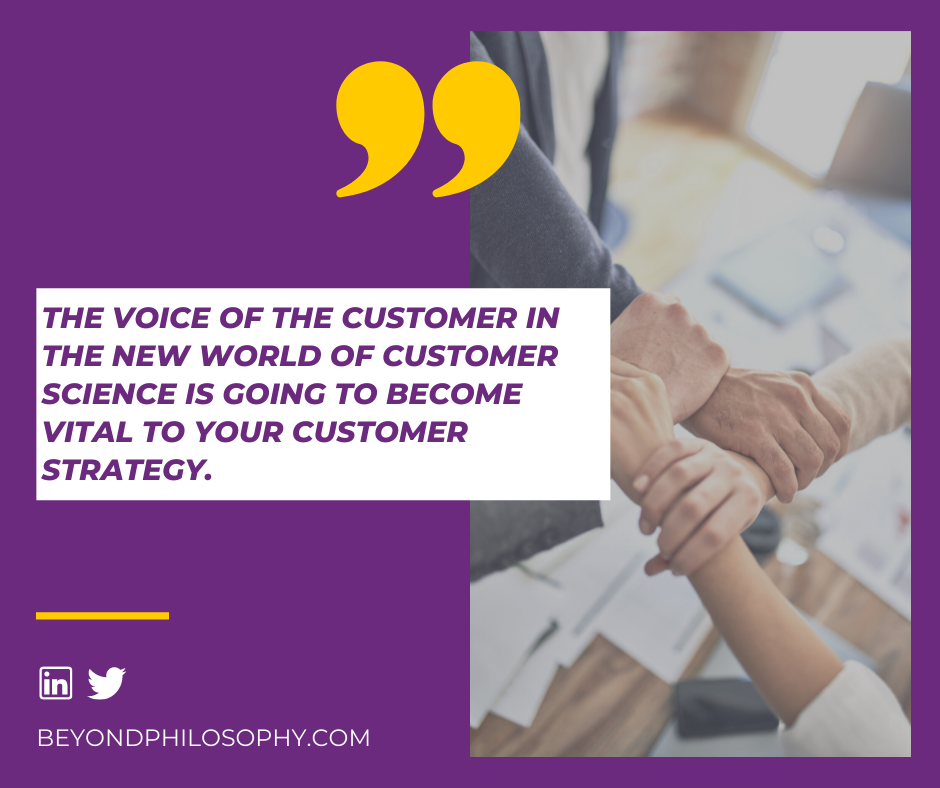Customer Science is an exciting new variant of Customer Experience. One of the crucial ways that the science is more powerful is the quality of the customer data you feed into the process. So, the question becomes, how complete is the data you would feed into the scientific process? If you are like many organizations, the answer is likely not complete enough.
I came to this realization in a discussion I had recently with a voice of customer expert. I was a guest on a webinar with Verint on the Engagement Capacity Gap, which discusses where organizations need to be in this area vs. where they are with the Chief Marketing Officer of Verint, Celia Fleischaker. Afterward, we discussed Customer Science and the role customer data will play in this latest evolution of customer experience. I invited her to the podcast to continue our discussion and wanted to share some of that insight here.
It Starts with Customer Science
Customer Science is where customer strategy is headed. It’s the convergence between behavioral science, AI, and data.
 The voice of the customer in the new world of Customer Science is going to become vital to your customer strategy. The voice of customers is another set of data that people can use to feed the AI and receive great insights about how they improve working with that customer, Fleischaker explains.
The voice of the customer in the new world of Customer Science is going to become vital to your customer strategy. The voice of customers is another set of data that people can use to feed the AI and receive great insights about how they improve working with that customer, Fleischaker explains.
Integrating the various data sources is something many organizations have on their to-do list. For example, companies tend to view customers in their profile data, meaning their transactions and interactions with different departments like sales and service.
However, data requires layering from various sources. If you only have one type of data, it’s challenging to make a meaningful insight from it.
When you layer in the experience and voice of the customer data, you drive understanding. However, it can seem overwhelming to bring all of that together from the various organizational siloes to drive insights, Fleischaker explains.
Moreover, many organizations need help interpreting their data. For my part, if a company isn’t looking at their data through the lens of the behavioral sciences, they aren’t leveraging the most valuable aspects of it. Fusing the data and then using a scientific approach to drive actions will.
In other words, it’s not only looking at the bulk of the layered data but also using science to make sense of it.
Fleischaker has a great example of a firm doing this well on the contact center side. A European insurer uses AI to use the data and the feedback to determine the next best action. However, she says they’re using it in real-time, meaning looking at that interaction as it’s happening.
 The insurance company uses AI to understand the sentiment along with acoustic analysis and then coaches agents on where to take that interaction and help that customer. Fleischaker says the company improved its first call resolution and enhanced the Customer Experience to create a substantial impact for them.
The insurance company uses AI to understand the sentiment along with acoustic analysis and then coaches agents on where to take that interaction and help that customer. Fleischaker says the company improved its first call resolution and enhanced the Customer Experience to create a substantial impact for them.
Sentiment analysis is critical here. It means you’re looking beyond the words that customers are saying and using to discover what they mean by them and how they are feeling. Fleischaker’s example shows a company interpreting that data using a behavioral science perspective.
How the data is collected is an essential consideration, too. For example, Fleischaker says many companies use audio and speech analytics. She also sees firms using text analytics for digital channel interactions. She considers all of these improvements over waiting for survey or feedback results. Furthermore, Verint is seeing clients combine those sources to analyze the overall experience and understand more about each interaction and determine what’s needed to improve and drive better engagement.
Engaging with Voice of Customer Data
However, as encouraging these examples are, I can’t help but feel pessimistic about how many organizations will respond to these challenges. I admonished my colleagues for never using the voice of customer research we undertook to do anything different in our approach during my corporate career. Instead of rising to my challenge, my colleagues thought we should stop doing the research. This example is one of many reasons I am no longer in corporate life.
Fleischaker has a different approach to spark engagement regarding the voice of customer data in companies Verint consults. First, companies should bring together all their data sources into a similar format so they can be analyzed together. Then, with a single data hub, AI can access it for analysis. Having these two processes in place makes it easier to create actionable insight with multiple data sources.
 From a marketing perspective, Fleischaker thinks having Customer Science integrated into your customer strategy expands what you can do. It’s an opportunity to uncover and leverage additional insights from interactions that occur across the organization. For example, the contact center was not part of marketing’s strategy in the past, but it is today. Fleischaker recognizes enormous customer strategy opportunities in the contact center’s data. Contact center teams are not only solving a service problem but also uncovering a chance to market and sell to customers. So, yes, Fleischaker has the traditional lead and pipeline building marketing efforts but discovered an even better opportunity to build a better relationship with customers when they contact the company.
From a marketing perspective, Fleischaker thinks having Customer Science integrated into your customer strategy expands what you can do. It’s an opportunity to uncover and leverage additional insights from interactions that occur across the organization. For example, the contact center was not part of marketing’s strategy in the past, but it is today. Fleischaker recognizes enormous customer strategy opportunities in the contact center’s data. Contact center teams are not only solving a service problem but also uncovering a chance to market and sell to customers. So, yes, Fleischaker has the traditional lead and pipeline building marketing efforts but discovered an even better opportunity to build a better relationship with customers when they contact the company.
Moreover, Customer Science provides an understanding of customers and the ability to empathize more with where customers are in that relationship. Layering that together to understand how they’re connected is very interesting and drives a lot of value.
(I’d like to encourage all of you to download the new Engagement Capacity Gap study and to register for Verint’s annual engagement conference in Orlando from June 13 to June 16.)
So, What Should You DO about This?
So, what’s the takeaway? What should you do about the Voice of Customer in the mix of data sources you fuse for your forays into Customer Science.
Here are a few suggestions:
- Understand the data you have and where it is in the organization. Like many things, having a good inventory of the various data sources is an excellent place to start. It is essential to survey what you have, where you keep it, and how it’s collected. It will let you know what you have plenty of, but it will also shed some light on what you need. Moreover, you can build a map to bring that data together in one place. This ability to integrate your data into one system, a single data hub, is foundational to using the AI to the full extent of its benefit.
- Try new things with your data. It’s easy to do what you have always done, running an analysis on your website data or charting your purchase data. The challenge is trying something new, like feeding your voice of customer data into your analysis models. However, excluding data because you don’t have as much experience with it is a foolish way to search for answers. The excluded data might hide the answers you need. So, try the new thing, combine the data even though it’s challenging, and you are far more likely to find the insight you need to drive your customer strategy.
- Remember, “Experts lose to data.” This great quote from Nobel-Prize-winning physicist Richard Feynman says it all. If you have the opportunity to join expertise with empirical results and then test, refine, and iterate to improve, then that’s a beautiful place to be.
It is essential to use all your customer data to combine AI and behavioral sciences. So, if you haven’t got one hub for all your data, including the voice of customer data you have, how can you be sure that the insights you get will be accurate? Moreover, the improvements to your experience based on what is possible with the customer and behavioral segmentation are outstanding. Without that data, layered and comprehensive, you miss out on a lot. I don’t see how you could get to the new land of Customer Science without it. So, I would encourage people to get serious about how they will make that change and take their customer strategy to the next level.
Verint sponsors this article.
Verint helps the world’s most iconic brands build enduring customer relationships by connecting work data and experiences across the enterprise. The Verint Customer Engagement Cloud Platform draws on the latest advancements in AI and analytics, an open cloud architecture, and the science of customer engagement to meet shifting customer interactions and their ever-increasing demands.
If you have a business problem that you would like some help with, contact me on LinkedIn or submit your pickle here. We would be glad to hear from you and help you with your challenges.
 There you have it. No promotions, no gimmicks, just good information.
There you have it. No promotions, no gimmicks, just good information.
Think reading is for chumps? Try my podcast, The Intuitive Customer instead. We explore the many reasons why customers do what they do—and what you should do about it. Subscribe today right here.


